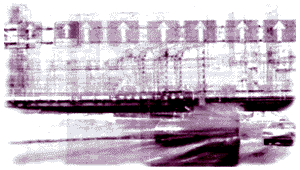As well as being thresholds between land and air, modern airports are gateways
to complexity. Through them, we enter the operating environment of global
aviation, surely mankind's most complicated creation. But in airports, although
we are isolated from the rhythms of the natural world, we remain ignorant of
how this artificial one works. The result is to reinforce what philosophers
call our ontological alienation: a sense of rootlessness and anxiety; of not
quite being real; of being.... lost in space.
In many respects aviation is typical of the way the whole world is going:
saturated with information and systems; complex but incomprehensible; an
exhilarating human achievement, and a terrifying prospect - at the same time.
It's time design came to grips with these ambiguous features of our
technological society. But I'll return to these broader issues at the end.
Right now, I want to focus on three design questions:
1 - why does air travel makes you feel strange?
2 - what can design do to improve the experience?
3 - why go in person, when you can call?
I believe answers to these three questions can be found by looking at the ways
that different kinds of space affect how we think and feel. Architectural space
is the first kind, perhaps best illustrated by the "pure architecture" of
someone like Tadao Ando. Then there is aviation space, the "operating
environment" within which airports, airplanes, electronic signals, and people,
interact with each other continuously on a global scale. Typical airport plans,
like this one in the middle, say almost nothing about the quality of our
interaction with these intangible systems and processes. These first two kinds
of space can be compared to a third: telematic space - the space of electronic
communications, information, highways of the mind, and so on.
In order to explain the strange way we feel when traveling by air, and the
impact on us of airport and aviation space, I need to explain a bit about the
aviation system as a whole, which determines what architects would call the
program of an individual airport building.
The world's airlines carried more than one billion passengers on scheduled
flights in 1993. That's equivalent to one sixth of the world's population.
Airlines also carried 22 million tons of freight last year, almost a quarter of
the total value of the world's manufactured exports. It took something like 12
million aircraft departures to carry such stupendous quantities of people and
goods around the world. These were to and from about 16,000 airports in the
Unites States alone, perhaps 30,000 in the world? Nobody actually knows - I
checked.
 But the aviation system's earthbound infrastructure is nothing compared to the
complexity of its operating environment, or aviation space. The aviation
system, of which airports are one component, is distributed not just in space,
but also in time. Airports exist at the intersection of airways - the space
through which aircraft pass - which exist in three spatial dimensions and are
densely criss-crossed by the routes planes are flying, did fly, and will fly.
But the aviation system's earthbound infrastructure is nothing compared to the
complexity of its operating environment, or aviation space. The aviation
system, of which airports are one component, is distributed not just in space,
but also in time. Airports exist at the intersection of airways - the space
through which aircraft pass - which exist in three spatial dimensions and are
densely criss-crossed by the routes planes are flying, did fly, and will fly.
Aviation space is also saturated with electronic information from humans and
machines, chattering out directions to thousands of aircrew and onboard
computers at any one moment. The fact that people - passengers, aircrew, ground
staff, air traffic controllers and the like - are part of the system, too,
means that when it comes to complex environments, forget the banks and dealing
rooms: airports are by far the most advanced "smart buildings" on earth.
And that's just the situation today. There are a lot more of them on the way: A
survey by Airports International magazine lists hundreds of new airport
projects around the world. There are places I've never heard of - exotic towns
spending billions of dollars on new facilities. Expansion of the system, and in
particular the construction rate of new airports, is staggering. And frankly,
more than a bit alarming (as I shall explain a bit later). No single world body
is responsible for the aviation system as a whole. There are thousands of
airlines: the breakup of Aeroflot produced 800 new ones in the USSR alone! Then
there are all sorts of airport operators and managers, some local, some
national, increasingly owned by private companies. There are supranational air
traffic control bodies, but they have an uphill struggle integrating national
systems. Nobody is coordinating this phenomenal expansion of the world's
aviation hardware. It's just happening, and such a stupendous investment of
money and materials cannot be explained rationally. It is far more than a
planned response to increasing traffic.
Politics are more potent than planning. Airports have become economic and
political touchstones against which cities and regions measure their status in
the world. The biggest international airports and major hubs - the United
States alone has 30 - are like giant pumps that greatly increase flow through
the whole system. In post-Cold War Europe there are also more than 300 emerging
cities or regional entities that are competing with each other to attract ever
more mobile capital and jobs. For them, and for hundreds of other cities and
regions around the world, airports have become strategic priorities.
But the costs are phenomenal. A single 747-capacity runway can cost $200m; an
international passenger terminals ranges from $100 million upwards. Once you
add in road and rail links, baggage handling systems, air traffic control
systems and so on, the capital cost of an international airport will quickly
exceed a billion dollars. For example, Japan's amazing new Kansai airport cost
$15 billion - insofar as anyone actually knows the full amount or is prepared
to say!
 The vehicular traffic generated by airports is enormous. Los Angeles
International generates more than 150,000 vehicle trips daily in and out of the
central terminal area alone, excluding long-stay car parks, warehouses, nearby
hotels and their suppliers. It's like designing a traffic system for a city
with more than half a million inhabitants.
The vehicular traffic generated by airports is enormous. Los Angeles
International generates more than 150,000 vehicle trips daily in and out of the
central terminal area alone, excluding long-stay car parks, warehouses, nearby
hotels and their suppliers. It's like designing a traffic system for a city
with more than half a million inhabitants.
Airports also have huge workforces. Frankfurt, which has more than 40,000, is
the biggest employment site in the whole of Germany. In order to handle more
than 1,000 airliner movements a day, London Heathrow employs 55,000 people
directly, including meteorologists, air traffic controllers, pilots, cabin
crew, cleaners, caterers, check-in staff, baggage handlers, engineers, firemen,
police, security guards. That excludes more than 300,000 or more employed
indirectly by a myriad of suppliers. All those van drivers and sandwich makers.
Airports are also the world's largest employers of dogs.
It is only because airports are multinational businesses in their own right
that these sorts of costs can be sustained. Indeed, commercial activity on the
ground, not aircraft taking off and landing, most heavily influences airport
design. Less than 50% of Heathrow's earnings now come from landing fees or
servicing aircraft. International transit passengers not flying spend an
average of $35 a head at Heathrow's hundreds of shops, restaurants,
hairdressers, and four caviar bars. Heathrow is also the largest market for
Havana cigars in the world - including Havana.
In days past, when airports were planned and operated as utilities for a select
elite, engineers and operations people would have regarded an idle passenger as
evidence of system inefficiency. Not today. To commercial managers, "passenger
discretionary time" - or "dwell time" - is a sales opportunity. Why else ask
people check in up to three hours before takeoff? This is one reason. Traffic
jams are another. It is significant that between 1950-1990, the proportion of
time passengers actually spent in the air steadily decreased.
So much for speed.
- 
 +
+
 But the aviation system's earthbound infrastructure is nothing compared to the
complexity of its operating environment, or aviation space. The aviation
system, of which airports are one component, is distributed not just in space,
but also in time. Airports exist at the intersection of airways - the space
through which aircraft pass - which exist in three spatial dimensions and are
densely criss-crossed by the routes planes are flying, did fly, and will fly.
But the aviation system's earthbound infrastructure is nothing compared to the
complexity of its operating environment, or aviation space. The aviation
system, of which airports are one component, is distributed not just in space,
but also in time. Airports exist at the intersection of airways - the space
through which aircraft pass - which exist in three spatial dimensions and are
densely criss-crossed by the routes planes are flying, did fly, and will fly.
 The vehicular traffic generated by airports is enormous. Los Angeles
International generates more than 150,000 vehicle trips daily in and out of the
central terminal area alone, excluding long-stay car parks, warehouses, nearby
hotels and their suppliers. It's like designing a traffic system for a city
with more than half a million inhabitants.
The vehicular traffic generated by airports is enormous. Los Angeles
International generates more than 150,000 vehicle trips daily in and out of the
central terminal area alone, excluding long-stay car parks, warehouses, nearby
hotels and their suppliers. It's like designing a traffic system for a city
with more than half a million inhabitants.

 +
+